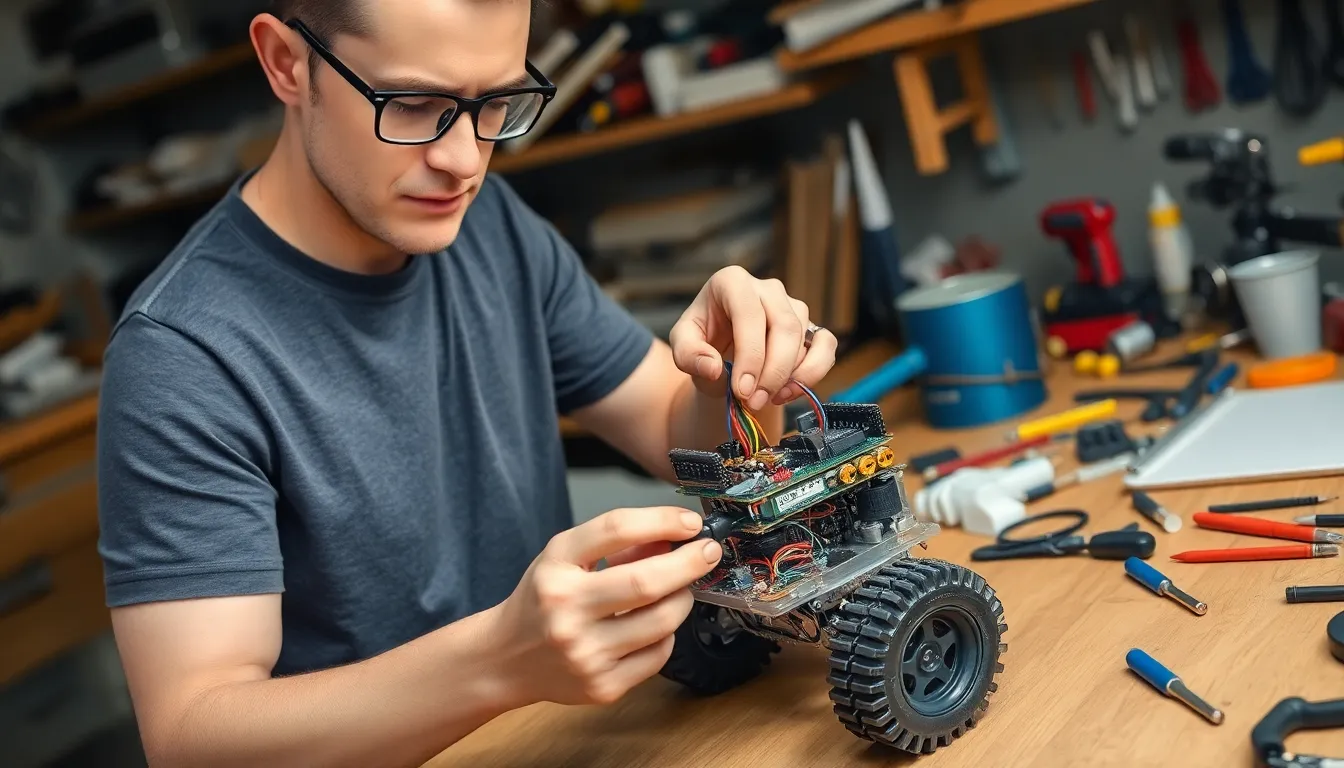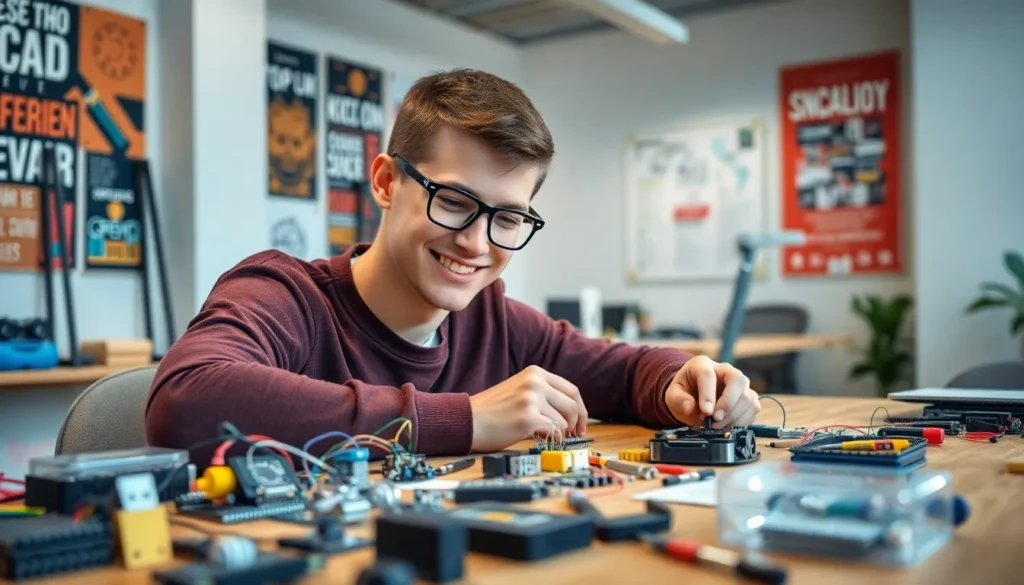Table of Contents
ToggleRobotics isn’t just for advanced engineers anymore. Simple robotics has opened the door for enthusiasts and beginners to dive into the fascinating world of automation. From DIY kits to educational resources, anyone can explore the basics of building and programming robots that perform simple tasks.
These accessible tools empower individuals to spark creativity and innovation. Whether it’s creating a small robot that follows a line or a simple arm that picks up objects, the possibilities are endless. With a little guidance, anyone can turn their ideas into tangible creations, making robotics an exciting field for all ages.
What Is Simple Robotics?
Simple robotics involves the creation and programming of basic robots that perform straightforward tasks. This field encourages exploration and creativity for beginners and enthusiasts through accessible tools and resources.
Definition and Scope
Simple robotics refers to the design and implementation of robots capable of executing fundamental functions, such as line following or object manipulation. This area encompasses DIY robotics kits, educational projects, and entry-level programming environments. Simple robotics provides an entry point for novices, allowing individuals to grasp essential concepts in mechanics and coding without extensive prior knowledge.
Importance in Modern Technology
Simple robotics plays a crucial role in advancing technology. It promotes engagement in STEM (Science, Technology, Engineering, and Mathematics) education by making learning interactive and practical. Simple robots illustrate core principles of automation, programming, and engineering, facilitating problem-solving skills. Additionally, they inspire creativity, prompting users to innovate solutions tailored to various tasks. In a technology-driven world, simple robotics cultivates a foundational understanding that can lead to more complex technology applications.
Key Components of Simple Robotics

Simple robotics involves several key components that work together to create functional robots. These components enable the robots to sense their environment, perform tasks, and follow programmed instructions.
Sensors and Actuators
Sensors detect changes in the robot’s environment and convert that information into signals for processing. Common types of sensors include:
- Infrared sensors: Measure distance and detect obstacles.
- Ultrasonic sensors: Use sound waves to determine proximity.
- Light sensors: React to light intensity, useful for line-following tasks.
Actuators move the robot based on sensor inputs and programming. Common actuator types include:
- DC motors: Provide rotational motion for wheels and joints.
- Servo motors: Allow precise positional control for specific applications.
- Linear actuators: Convert rotary motion into linear movement for tasks like lifting.
Microcontrollers and Programming
Microcontrollers serve as the brains of simple robots, executing commands and processing sensor data. Popular microcontrollers include:
- Arduino: Known for its user-friendly programming environment, making it ideal for beginners.
- Raspberry Pi: Offers advanced computing capabilities for more complex projects.
Programming involves writing code that instructs the robot on how to respond to sensor inputs. Common programming languages used are:
- C/C++: Predominant in Arduino programming due to its efficiency and control.
- Python: Frequently used with Raspberry Pi for its simplicity and readability.
By combining sensors, actuators, microcontrollers, and programming, enthusiasts create robots capable of performing basic tasks, enhancing their understanding of robotics through hands-on experience.
Applications of Simple Robotics
Simple robotics finds applications in various fields, enhancing learning, creativity, and practical skills. This section covers educational uses and DIY projects that exemplify the accessibility and versatility of simple robotics.
Educational Use in Schools
Simple robotics plays a significant role in classrooms, actively promoting STEM education. Schools incorporate basic robotics into curricula, encouraging students to engage with fundamental concepts of science, technology, engineering, and mathematics. Through hands-on activities, students learn programming, critical thinking, and problem-solving skills, fostering a deeper understanding of automation.
Programs utilize robotics kits, which include components like sensors and actuators. These kits allow students to build functioning robots that complete assigned tasks, such as navigating mazes or responding to environmental stimuli. This experiential learning supports collaboration among students, boosts their confidence, and inspires interest in pursuing advanced studies in technology-related fields.
DIY Projects and Hobbies
DIY projects represent a popular application of simple robotics, enabling individuals to explore their creativity. Enthusiasts design and build robots using accessible kits and online resources. These projects can vary from basic line-following robots to more complex creations like robotic arms.
Hobbies in simple robotics encourage experimentation with circuits, programming, and mechanical design. Individuals can customize their robots, enhancing features or modifying functionalities to achieve specific outcomes. This hands-on approach not only nurtures technical skills but also fosters a sense of accomplishment when creating unique robotic solutions.
Challenges in Simple Robotics
Simple robotics faces several challenges that can affect the learning experience and project outcomes. Understanding these difficulties is crucial for enthusiasts and educators.
Common Limitations
Common limitations in simple robotics include technical constraints, resource availability, and learning curves.
- Hardware Limitations: Many DIY kits provide basic components, which may restrict the functionality of robots. Enthusiasts may encounter difficulty in executing complex tasks due to insufficient hardware.
- Programming Challenges: Basic programming knowledge is essential for controlling robotic functions. Newcomers might struggle with coding languages like C/C++ or Python, leading to frustration.
- Cost Factors: While many kits are affordable, high-quality components often come at a premium. Budget constraints may limit access to better tools and resources.
- Complexity in Integration: Combining multiple components into a functioning robot requires a solid understanding of mechanics and electronics. This integration often presents a steep learning curve for beginners.
Safety Considerations
Safety considerations play a significant role in simple robotics projects.
- Electrical Safety: Beginners must handle electrical components carefully to avoid shocks and short circuits. Proper insulation and grounding techniques should always be applied.
- Mechanical Safety: Moving parts can pose hazards, particularly with sharp edges or high speeds. Enthusiasts should design robots with safety measures to protect users and bystanders.
- Environment Risks: Operating robots in unsuitable environments might lead to failures or accidents. Selecting appropriate settings for testing and usage is essential.
- Supervision and Guidance: Young learners should work under adult supervision to ensure safe practices. This guidance helps mitigate risks and fosters an environment of constructive learning.
Future Trends in Simple Robotics
Simple robotics is evolving rapidly, driven by advancements in technology and its potential to impact various industries. Key trends shaping the future include enhanced automation, artificial intelligence integration, and growing educational applications.
Advancements in Technology
Technological advancements significantly influence simple robotics. Innovations in sensor technology enable robots to interact seamlessly with their environments. Enhanced sensors allow robots to detect obstacles with greater precision, improve navigation capabilities, and facilitate complex interactions. Likewise, developments in microcontrollers simplify programming, making it accessible for novices. Newer platforms, such as Raspberry Pi Pico and ESP32, offer powerful features while maintaining ease of use.
Affordable components, like high-performance servos and open-source programming tools, lower the barrier to entry for hobbyists. These improvements allow enthusiasts to build more capable robots that can perform advanced functions, such as voice recognition and autonomous navigation. Furthermore, cloud computing and machine learning applications provide real-time data processing, enhancing robotic capabilities in various applications.
Potential Impact on Industries
Simple robotics significantly impacts various industries, including education and manufacturing. In education, it encourages engagement in STEM fields by providing hands-on experience with technology. Schools adopting robotics programs see increased student interest in engineering and computer science. These programs foster creative problem-solving and collaboration among students.
In manufacturing, simple robotics automates repetitive tasks, increasing efficiency and reducing labor costs. Small businesses benefit from using affordable robotic systems to streamline operations and maintain quality control. Innovations within simple robotics will further drive productivity enhancements, as companies integrate robots into their workflows. Additionally, healthcare services utilize basic robotic systems for tasks like inventory management and patient monitoring, improving operational efficiency and patient care.
The future of simple robotics foreshadows widespread applications across numerous sectors, transforming how individuals and organizations interact with technology.
Simple robotics opens doors to creativity and innovation for enthusiasts of all ages. By engaging with DIY kits and educational resources, individuals can grasp essential concepts in mechanics and coding while building functional robots. This hands-on approach not only enhances problem-solving skills but also fosters a deeper interest in STEM fields.
As technology continues to evolve, the future of simple robotics looks promising. Enhanced automation and AI integration will likely expand its applications across various industries. With ongoing advancements, the accessibility of robotics will inspire more people to explore this exciting field, transforming ideas into tangible creations that could shape the future of technology.







